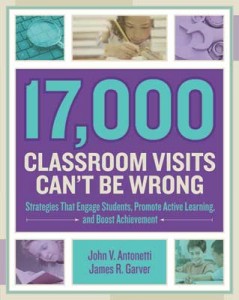17,000 Classroom Visits Can’t Be Wrong
17,000 Classroom Visits Can’t Be Wrong – Strategies That Engage Students, Promote Active Learning, and Boost Achievement
By John V. Antonetti and James R. Garver
(ASCD, 2015 – Learn more)

Where do I start? I absolutely LOVE this book. It is one of those teaching texts you will carry around everywhere with you, refer to often, and reread over the summer to make sure your current teaching practices are on track. You will not be wasting your money when you purchase 17,000 Classroom Visits Can’t Be Wrong. Antonetti and Garver lead the reader on a learner-focused expedition as they take you through years of classroom observations.
This book is organized into thirteen chapters:
Focus on Learning
- How to Use this Book
- Thinking and the Brain
- Learning Targets
- Know Your Learners
- Engagement
- Instructional Strategies
- Differentiation
- Learning Pathways
- Closure
- Reflection
- Putting It All Together
- Final Thoughts
Right from the beginning, the authors shift from teaching to learning. When they visited over 17,000 classrooms, their goal was observing students during the learning process, not examining the teacher. In the words of the authors: “Focusing on students during academic activities provided the greatest clarity into the achievement results.”
What’s inside the book
With the focus on learning, the chapters have many features to make the book user-friendly. At the start of each chapter, a student journal is included where a 7th grader shares some of his reflections on his classroom experiences. Look 2 Learning data (the authors’ walkthrough model) from more than 17,000 classroom visits supports each topic.
Each chapter provides research findings and implications. The authors also include dialogue between the two of them as they discuss the topic. The chapters include practical tools for teachers to implement right away. Finally, they provide school stories, think-abouts to inspire reflection, and closure activities.
Out of all the chapter features, I find the school stories, teacher tools, and research to be the most useful. I flagged many tools in the book and was able to use them immediately in my classroom. For example, there is a tool to bring the Venn Diagram to the next level of cognitive demand by adding lines to categorize the information in the diagram. This is just one example of the many useful strategies from the book.
A useful way to put the ideas to work
My favorite section of the book is Putting It All Together. Up until this section, I marked so many amazing concepts/strategies in the book I couldn’t help but wonder how I was going to pull it all off. As though the authors were reading my mind, they provided an answer to my question.
The book includes two graphics as tools to help teachers increase the effectiveness of the learner tasks in our classrooms. I plan on using them to analyze my own current tasks and bring them to the next level of engagement, academic strategies, and cognitive demand. 17,000 Classroom Visits Can’t Be Wrong leaves the reader feeling empowered and ready to make positive changes. It is a must read.
Jennifer Druffel is a fifth grade teacher in Spokane Valley, WA. She is endorsed in Elementary Education and K-12 Reading Instruction. She engages students through authentic experiences such as genius hour and blogging at MrsDruffelsClass-2. Being naturally driven to always better her practice and inspire her students fuels her research and connectedness as an educator. Follow her @MrsDruffel and jendruffel.wordpress.com\































